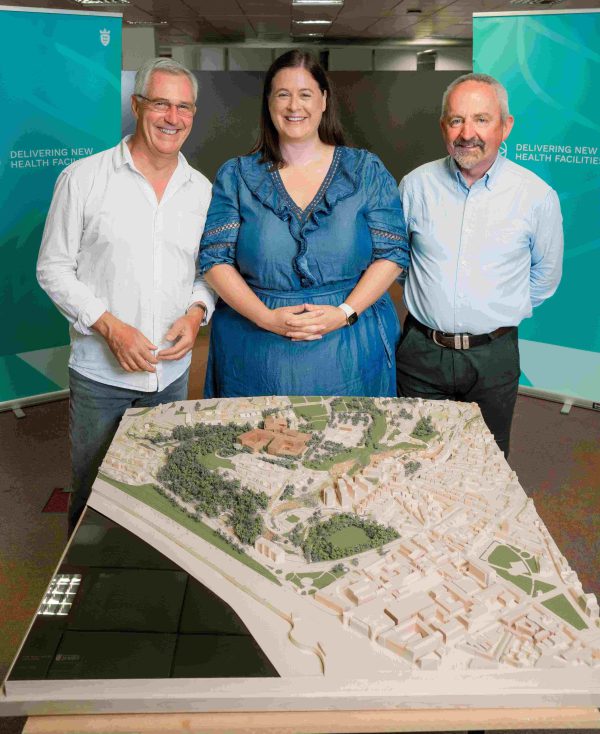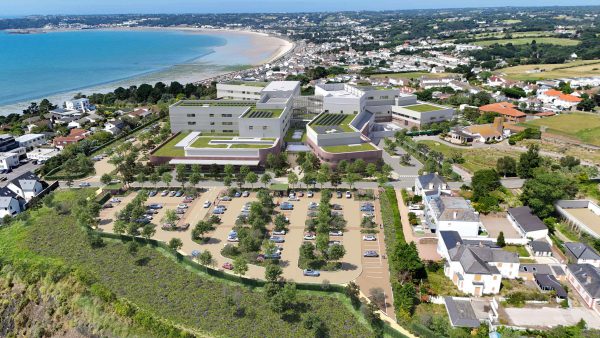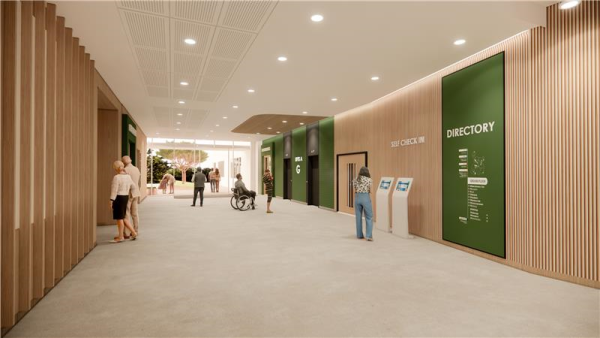
This blog is a conversation between the three independent advisors supporting the Minister for the New Healthcare Facilities Programme in Jersey. Their diverse expertise brings transparency, informed oversight, and a balanced representation of Islander voices to this significant infrastructure project.
Dr Nigel Minihane is a retired General Practitioner with over 30 years of experience in Jersey. He remains active in healthcare policy, representing GPs through the Primary Care Body and contributing to government policy on primary care.
Michelle Ryan, Director of a local sustainability firm, is a strong advocate for patient and public voices. As co-chair of Jersey Maternity Voices and a former member of the Our Hospital citizens’ panel, she brings a focus on user perspectives. Her background includes senior roles in finance and sustainability.
John Rogers is a former Director General for Growth, Housing and Environment, with deep expertise in capital project delivery on the Island. An engineer by training, his areas of expertise are construction, procurement, and managing complex infrastructure in Jersey’s unique context.
Together, the trio advises the Minister for Health and Social Services, Deputy Tom Binet, offering independent insight and governance oversight, ensuring the healthcare programme reflects clinical needs, patient voices, and practical realities of delivering major projects in Jersey.

The three independent advisors with a model of the Overdale Acute Hospital (from left):
Dr Nigel Minihane, Michelle Ryan
and John Rogers
What progress has been made since the Programme began in 2023?
“This is a programme of projects – not just a single building,” explains Michelle. “It’s about regenerating our entire health infrastructure to meet future needs.”
The current model replaces earlier proposals with a phased approach aligned to clinical need. Nigel describes it as a “clinically driven, integrated model” that separates acute, intermediate, and long-term care to deliver more responsive services.
A 2022 independent review provided the foundation for this shift . “It was a factual analysis – what’s feasible, what’s affordable, and how to deliver the best outcome for Jersey.”, says Michelle.
John highlights the planning and political milestones: “All the strategic groundwork – the outline case, capital decisions, and planning permissions – has been completed at pace. The project is now moving into the more exciting phase of construction.”
Those key milestones include the opening of the Enid Quenault Health and Wellbeing Centre at Les Quennevais in 2023, the start and completion of demolition at Overdale (December 2023– Nov 2024), the relocation of Samarès Ward to St Ewold’s (May 2024), and a public consultation on the Acute Hospital’s concept designs to support the Planning Application.
The Outline Business Case was approved in November 2024, securing Phase 1 funding from the States Assembly. Design work for the Acute Hospital progressed throughout 2024, with planning permission granted earlier this year. Meanwhile, the procurement process to appoint a Main Works Delivery Partner has been ongoing since December 2024.
Why was a multi-site model chosen instead of a single-site hospital?

Attempts to deliver a single, mostly-on-one site hospital failed for many reasons, including changes in global economic circumstances and the pandemic. John explains: The multi-site approach is more flexible, scalable, and resilient – qualities that proved essential during the COVID-19 pandemic “That traditional ‘one big hospital’ model was unachievable and didn’t reflect how healthcare is evolving.”
The model also draws on lessons from other jurisdictions. “This isn’t just a Jersey idea,” adds Nigel. There’s good evidence from elsewhere, like Northern Ireland, that this works.” Public engagement shaped the design.
“People told us that if you’re staying in hospital, you want nature, quiet, dignity,” says Michelle. “But if you’re popping in for a quick appointment, you want convenience. This model balances both.”
What services will be located at the various sites?
Overdale will become home to the new acute hospital, housing emergency services, births, surgery, and inpatient wards. “This is the core of what we desperately need,” says Nigel. “It includes essential diagnostics like scanners, and there’s been great work on ambulance access and flow.”
The Kensington Place site will provide ambulatory and urgent care services. “If you’re walking in, chances are you don’t need A&E,” says Michelle. “It’s for things like minor injuries, physiotherapy, or outpatient care – services that benefit from being in town.”
Each of the three key locations will play a distinct role:
- Overdale – Acute Hospital
- Emergency care
- Overnight surgery and operations
- Maternity and inpatient wards
- On-site diagnostics (scanners, imaging)
- Ambulance access designed for flow and efficiency
“This is what we desperately need,” said Nigel. “A functioning acute hospital with modern infrastructure.” - Kensington Place – Ambulatory Care
- Urgent care (walk-in injuries, minor ailments)
- Outpatients, physiotherapy, diagnostics
- Day surgery
- Easily accessible town location
“If you can walk in, you probably don’t need A&E,” noted Michelle. “Kensington Place will handle those cases – conveniently and appropriately.” - St Saviour’s Health Village
- Mental health services
- Dementia and rehabilitation care
- Step-down and community-linked support
- Designed as a calm, stigma-free environment
“This won’t be just a mental health facility,” said Nigel. “It’ll be a true health village, deeply connected to the community.”
Meanwhile, St Saviour’s Health Village will deliver long-term, community-linked care, particularly in mental health, rehabilitation, and dementia services. “This isn’t just a mental health hospital,” says Nigel. “It’s a village – one that integrates with the community and reduces stigma.”
The design ensures that services are in the right locations for patients and staff alike. “It’s horses for courses,” Michelle adds. “Different needs require different environments – and now we have a plan for all of them.”
What’s currently happening at Kensington Place and St Saviour?
Work is already underway across all sites albeit it is most advanced at Overdale. With the appointment of the main works delivery partner, attention will move back to Kensington Place and St Saviour, firstly through a review of the original feasibility studies ensuring that these remain relevant and appropriate and to help prioritise the first physical works. For St Saviour’s Health Village, improvements will need to progress carefully. “It’s a live site, so it’s challenging,” says John. “But the future plans are being developed in parallel with the hospital to avoid delays later.” They will also be carefully phased to minimise disruption to patients and surrounding residents.
Kensington Place remains operational until the new facilities are ready. “It was declared not fit for purpose 15 years ago,” notes John. “Health and Care Jersey is keeping it going with necessary upgrades until the transition.”
Minimising disruption is key. “The idea is to move services just once, not three or four times,” adds Michelle. “That’s made a big difference to staff confidence.”
Meanwhile, major progress has been made at Overdale, where demolition is complete and preparatory works are underway. “We’ve relocated services, prepped the site, and even marked out the footprint of the new hospital,” says Michelle.
Nigel also praised the more modest scale: “It’s less intrusive than earlier designs and has been carefully planned from multiple visual points across the Island.”
What improvements in care can Islanders expect to see?

The new healthcare facilities aim to raise both the quality and experience of care for patients and staff. Nigel highlights the improved layout: “The wheel-and-spoke design improves efficiency, increases privacy – particularly for end-of-life care – and allows future flexibility as needs change.”
The Programme has also invested in detailed scenario mapping. “The team has looked at what happens in real-life situations – from a child bumping their head to someone having a heart attack,” says Michelle. “It’s about planning for dignity, privacy, and timely access to care.”
Staff journeys were also a major focus. “From changing rooms to quiet spaces for reflection, everything has been designed with staff wellbeing in mind,” she adds.
John points to the concept of clinical adjacencies – ensuring related departments are placed close together to improve patient flow and reduce inefficiencies. “A nurse shouldn’t have to walk miles to get from diagnostics to a ward. The design is clever and considered.”
One area the team is especially keen to improve is diagnostics. “Jersey is currently behind in this area,” says Nigel. “Faster access to imaging and tests will enable earlier diagnosis and more effective treatment.”
What’s next – and when can we expect to see building work start?
The final stage before major construction begins is the appointment of a Main Works Delivery Partner.
“Right now, we’re selecting the contractor,” says John. “It’s not simple – working on an island presents logistical challenges, from ferries to accommodation. But we hope to award the contract by December.”
That partner will then be responsible for delivering the acute hospital, with work expected to begin shortly after.
Michelle highlights the importance of process: “It’s been really well governed. The decisions being made now are rooted in public interest, not personal politics. And there’s genuine cross-government support to get this done.”
Once the main works delivery partner is appointed, Islanders can expect to see construction activities increase significantly. “That’s when all the diligence, planning, and clinical input will start becoming real for people,” Michelle says.
Site preparation, they added, will continue over the summer. Hoardings will be erected, service infrastructure will be moved, the site will be cleared and groundworks will be started. Clearly these works will include spades too, however the timeline for the main construction works remains dependent on the delivery partner, who once onboard, will take over the site and determine the programme and sequencing. This flexibility is important since it will ensure that works are planned in the most efficient way possible, delivering best value for Islanders in the shortest possible timeframe.
The New Healthcare Facilities Team will be hosting two pop-up events for the public on Monday 11 and Wednesday 27 August, from 11am-2pm at Charing Cross, St Helier. Come along to speak with the team to find out more about the programme and ask any questions you may have.
 blog.gov.je
blog.gov.je